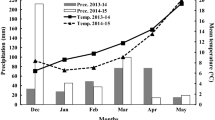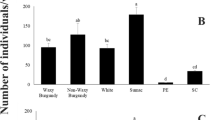Abstract
In a screen cage study, the pattern of flower and pod development at the various flowering nodes of three cowpea varieties with known susceptibility to the pod-borer Maruca testulalis, was mapped out. The period of flower opening over the whole plant spanned an average of 13 days in TVu 946, 17 days in ICV-2 and 18 days in Vita-1 with 85-100% of the pods retained to maturity coming from flowers opening within 8 days of anthesis. The efficiency of pod production from open flowers was highest in TVu 946 (54%), lowest in Vita-1 (11%) and median in ICV-2 (31%). However, as a consequence of the individual pod size, the overall pod and seed characteristics in decreasing order were Vita-1, ICV-2 and TVu 946. The bulk of flowers and pods on the plants were produced at the basal plant nodes where primary branches were developed.
Pod elongation and enlargement were initially rapid in all varieties, but the TVu 946 pods reached physiological maturity 2 days before the other two varieties. The eventual pod size and rate of pod growth appear to be important factors in the susceptibility of cowpea to the pod-borer attack.
Résumé
Dans une étude menée dans un écran grillé, le déssein du développement de la fleur et de la gousse aux noeuds à fleurs variés de trois variétiés du pois à vaché avec susceptibilité an bruche de pois Maruca testulalis était tracé. Le temps de l’ouverte des fleurs sur la plante entière a durée un moyen de 13 jours dans la variété TVu 946, 17 jours dans la variété ICV-2 et 18 jours dans la variété Vita-1. 85 à 100 pourcent des gousses ont retenu jusqu’à à la maturité venant des fleurs sont ouvert pendant une période d’anthèse qui a durée 8 jours. L’éfficacité de la propagation des gousses de fleurs ouvertes était plus élevée dans la variété TVu 946 (54%), plus bassedans la variété Vita-1 (11%) et moyenne dans la variété ICV-2 (31%). Cependant, les traits caractéristiques de la gousse de dimensions d’encombrement et des graines suivaient l’ordre Vita-1 > ICV-2 > TVu 946, par conséquence de la dimension individuel des gousses. La masse des fleurs et des gousses sur les plantes ont poussées aux noeuds basales où les branches primaires avaient développe.
L’allongement et l’agrandissement des gousses étaient rapide a l’étape initiale de développement dans les trois variétés mais les gousses du TVu 946 out atteint lar maturité physiologique deux jours avant ceux des autres variétés. La dimension aléatoire et la vitesse de l’accroissement de la gousse semblent ètre des agents importants dans la susceptibilité des pois à vaché a l’assaut du bruche de pois.
Similar content being viewed by others
References
Anonymous (1975) International Institute of Tropical Agriculture Annual Report, Ibadan, Nigeria, 1975 pp. 97–98.
Ojehomon O. O. (1968) Flowering, fruit production and abscission in cowpea, Vigna unguiculata (L.) Walp. J. W. African Sci. Assoc. 13, 227–234.
Ojehomon O. O. (1970) Effect of continuous removal of open flowers on the seed yield of two varieties of cowpea, Vigna unguiculata (L.) Walp. J. Agric. Sci. Cambridge 74, 375–381.
Suh J. B. and Simbi C. O. (1983) Studies on the legume pod borer M. testulalis (Geyer)—VII. Cowpea phenology and yield loss assessment: Effect of loss of leaves, shoots, flowers and pods on cowpea yield in Western Kenya, Insect Sci. Applic. 4, 89–96.
Summerfield R. J., Pate J. S., Roberts E. H. and Wein H. C. (1985). The physiology of cowpeas. In Cowpea Research, Production and Utilisation (Edited by Singh S. R. and Rachie K. E.), pp. 65–101, John Wiley & Sons.
Tayo T. O. (1982) Growth, development and yield of pigeon pea (Cajanus cajan (L.) Millsp.) in the lowland tropics, 3. Effect of early loss of apical dominance. J. Agric. Sci. Cambridge 98, 79–84.
Author information
Authors and Affiliations
Rights and permissions
About this article
Cite this article
Tayo, T.O. Flower and Pod Development in Three Cowpea (Vigna unguiculata (L.) Walp.) Varieties with Varying Susceptibility to the Pod-borer, Maruca testulalis (Geyer). Int J Trop Insect Sci 9, 249–253 (1988). https://doi.org/10.1017/S174275840000607X
Received:
Published:
Issue Date:
DOI: https://doi.org/10.1017/S174275840000607X
Key Words
- Cowpea susceptibility
- pod-borer
- Maruca testulalis
- flower and pod production
- pod and seed characteristics




